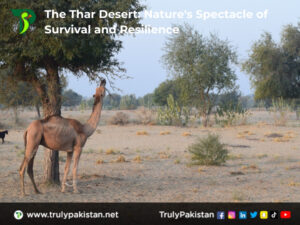Geological Marvel: A Landscape of Extremes
Formation and Terrain
The Thar Desert’s genesis is a tale written in the shifting tectonic plates of the Earth. It came into existence when the Indian subcontinent collided with the Eurasian tectonic plate, uplifting the majestic Aravalli Range and casting a shadow of aridity. The result is an awe-inspiring desert that defies convention with its sprawling sand dunes, rocky expanses, and sparse greenery.
Sculpted by Sand Dunes and Salt Flats
One of the Thar Desert’s most captivating attributes lies in its towering sand dunes, with some soaring to astonishing heights of 500 feet. These majestic, rolling waves of sand form a surreal and enchanting vista that has enraptured the wanderlust of travelers and ignited the creative inspiration of artists for countless generations.
The desert’s landscape is further adorned with salt flats, adding to its stark beauty and serving as unique habitats for specialized flora and wildlife.
Flora and Fauna: Life Finds a Way
Unexpected Biodiversity
Beneath the seemingly harsh exterior lies a surprising wealth of flora and fauna, each uniquely adapted to endure the unforgiving climate. Desert plants, such as the resilient babool and the hardy Cheri trees, play a pivotal role in preventing soil erosion and providing sustenance to both wildlife and local communities.
Wildlife in the Desert:
The Thar Desert teems with wildlife, each species specially crafted for its environment. From the elusive Indian gazelle, known locally as the chinkara, to the well-disguised desert fox and the regal Indian wild ass, the region’s fauna reflects both diversity and resilience. For bird enthusiasts, the desert is a winter sanctuary for migratory species, including the graceful Demoiselle crane.

People and Culture: Resilience Amidst Adversity
Indigenous Communities
In addition to its unique flora and fauna, the Thar Desert shelters indigenous communities that have developed intricate systems for thriving in this unforgiving terrain. Tribes like the Rabari and Bhil are pastoral nomads, celebrated for their profound connection to the land and their expertise in animal husbandry. Their vibrant traditions and distinctive attire enrich the cultural fabric of the region.
The Art of Desert Living:
Survival in the Thar Desert revolves around safeguarding the precious resource of water. The construction of step-wells, locally referred to as ‘baolis,’ and the ingenious use of windcatcher towers, known as ‘saguaros,’ stand as architectural marvels. These structures not only provide water but also foster a sense of community that has endured for generations.
Tourism: Exploring the Desert’s Charms:
Desert Safaris and Camel Rides
For intrepid explorers, the Thar Desert offers a trove of adventures. Guided desert safaris, led by knowledgeable locals, offer a chance to traverse the vast sand dunes and witness the desert’s thriving wildlife up close. Camel rides through the desert provide a unique perspective, immersing visitors in the serenity and grandeur of this exceptional ecosystem.
Cultural Immersion:
Visitors to the Thar Desert can partake in cultural exchanges with the local communities. Traditional folk music and dance performances provide a glimpse into the vibrant culture of the desert dwellers. Staying in rustic desert camps and savoring local cuisine beneath a star-studded desert sky create enduring memories of this remarkable land.
In the heart of the Thar Desert, nature’s spectacle of survival unfolds, revealing a world of contrasts, resilience, and breathtaking beauty that continues to captivate the hearts of all who venture into its embrace.

